Gardner and Penn, Jekyll and Hyde
Between 1956 and 1981, math and science writer Martin Gardner wrote the Mathematical Games column, a series of popular recreational math diversions in Scientific American. Gardner’s gift to the world was to rescue us from the school-borne tedium and fear of math, showing us that mathematics could be elevated into something that could be enjoyed and appreciated. He was one of the heroes of my youth, helping to spark a sense of curiosity in mathematics that still drives me.
Some of Gardner’s wonderful puzzles, games, and curiosities.
He even wrote a book about codes and ciphers.
I recently found an index to a collection of Martin Gardner’s correspondences and notes at Stanford University, and was surprised to discover that some of them pertain to the Zodiac ciphers. Naturally, I had to order photocopies and have a look.
Among the collection are letters that writer and amateur sleuth Gareth Penn wrote to Gardner in 1981 and 1984. Those who follow the Zodiac case have probably heard of Gareth Penn, a man who, for over twenty years, has obsessively written reams of material with bizarre theories linking UC Berkley professor Michael O’Hare to the Zodiac killings. Penn’s fixations have also drawn suspicions that he himself is the Zodiac killer. For a better background on this fascinating example of misplaced obsession, read “With Malice Aforethought” by Michael Martin, and Michael O’Hare’s own responses to the whole affair.
In his first letter to Gardner, Penn writes about how much he enjoys Gardner’s column on mathematical puzzles, and encloses copies of his various articles and writings about the Zodiac Killer:
- 11.0010010000 11111101101 (copy 1) (on Google Docs) | (on Ecphorizer.com)
- 11.0010010000 11111101101 (copy 2) (on Google Docs) | (on Ecphorizer.com)
- 340-character cipher – A few readings (on Google Docs)
- Incline Village Unit 6 (on Google Docs) | (on Ecphorizer.com)
- One Zero Zero (on Google Docs) | (on Ecphorizer.com)
- Portrait of the artist as a mass murderer (on Google Docs)
- Te Moriarty Salutamus (on Google Docs) | (on Ecphorizer.com)
- The 340 character cipher (on Google Docs)
- The calculus of evil (on Google Docs)
- Untitled (on Google Docs)
In these articles you will encounter Penn’s confusing layers of mathematical tricks that give his writing an air of authenticity. Surely Penn has uncovered something important about the Zodiac case by discovering all of these mathematical clues. When investigated, however, these elaborate setups are quickly revealed to be a type of selection bias that makes random coincidences appear to be significant.
Gardner did not fall for Penn’s tricks, and quickly determined the validity of his work, as suggested by his handwritten annotation on Penn’s closing:
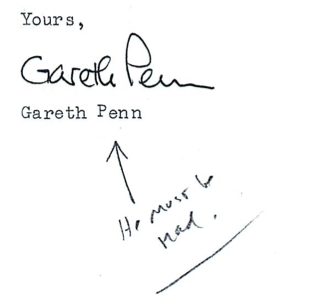
Three years later, Penn submitted another letter with his articles to Gardner. In the letter, Penn says that he, too, made the same discovery as Gardner did about the fun fact that the word “WIZARD” spells itself in the “reverse alphabet”, a technique Penn claims Zodiac employed in his correspondences.
Here’s how it works. First, write the letters of the alphabet in order, and write it again backwards underneath:

Mark the letters of the word WIZARD:

Then mark the letters below:

Now replace the letters of the word WIZARD with the letters from the reverse alphabet:
WIZARD = DRAZIW
DRAZIW is WIZARD backwards. Gardner informed Penn in his reply that, in fact, Gardner had already mentioned the symmetry of the word in a 1972 article in Scientific American (and revisited in this book). Gardner wrote about such things to share their fun and curious aspects, while Penn attempted to implicate them in an grand, complex scheme of puzzle clues implemented by the Zodiac killer. Like a sort of Jekyll and Hyde, Gardner and Penn displayed two different faces of the same mathematical curiosity.
Here is another example of Penn’s claims, in which he uses mathematical tricks to make you think that simple coincidences are important and significant. In his article about the 340 cipher, Penn divides the cipher symbols into two categories: “Geometric forms” and “letters”. The geometric forms include circles, squares, triangles, straight lines, and crosses:
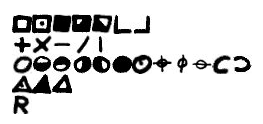
He includes the  because it is the 18th letter of the alphabet, and 18 is divisible by 9, a number Penn believes has numerological significance to the Zodiac killer.
because it is the 18th letter of the alphabet, and 18 is divisible by 9, a number Penn believes has numerological significance to the Zodiac killer.
And these are the “letters”, or non-geometric forms:

Penn re-writes the cipher text by replacing the symbols with zeroes and ones. The ones mark the geometric symbols, and the zeroes mark the non-geometric symbols. He leaves the dots alone. Here is the resulting grid:
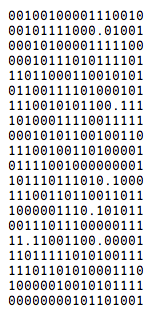
The “clue” left by Zodiac, according to Penn, is the appearance of the word “MIKADO”, the play Zodiac frequently references in his correspondences. How does the word appear? First, convert the word “MIKADO” into Morse code:

Then, convert the dashes into ones, and the dots into zeroes:
11 00 101 01 100 111
Remove the spaces:
110010101100111
And, look! It appears in the grid:
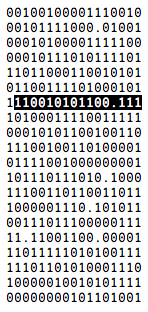
Seems incredible. But what Penn fails to tell you (and perhaps himself) is that in the same grid, you can find over 2,000 words that are at least four letters long. For example, the word INTEGRATE in Morse is 0010101100100110, and is easily found in the grid:
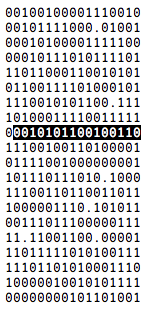
Did Zodiac hide any of the thousands of other words, too? How can we know which words are intentional and which aren’t? Here is the full list of the numerous words you can find in the same grid.
How is it possible to find over 2,000 words in a grid that only has 340 characters? The reason has to do with ambiguous interpretations of Morse letters.
Take for instance the binary string 10100010000. If you convert it back to Morse code, it looks like this:

The same Morse code translates to several different words, depending on where you draw the letter boundaries:

The number of possible letter boundaries goes up exponentially with the length of the binary string, which explains why so many different words can be found. Thus, there’s nothing special about the appearance of the word “MIKADO”. In fact, you can generate completely random binary sequences, and still find several thousand words.
In his postscript, Gardner mentions how quickly he was able to find the number “666” within the binary grid, using Penn’s own methods, which he calls nonsense in an annotation on Penn’s 340 worksheet.
Around the same time period as these letters, Penn attracted the attention of the FBI, whose cryptographic analysis of Penn’s material concluded the following:
The submitted material has been reviewed for the purpose of determining if the [redacted] “decryption” is valid. Unfortunately, the “solution” advanced by Mr. [redacted] does not lend itself to cryptographic validation in the same sense as traditional cryptographic systems. There are elements of his theory which include standard cryptographic techniques such as the “WIZARD” and “Binary-Morse” substitutions. The bulk of the theory, however, is based on speculation and a multitude of assumptions. It is possible that some of the assumptions are correct. Many, if not most, appear to be forced with results being used selectively if they are in keeping with the overall theme of the solution. For example, the [redacted] decrypt of the 340-character cipher is based upon a series of assumptions and ultimately does not represent a unique solution, but one that generally agrees with the rest of the solution. (To Mr. [redacted] credit, he points out that he is making assumptions and gives his basis for those assumptions.)
In the final analysis, without Zodiac to describe what he meant in his various communiqués, it will be impossible to know with certainty what, if any, hidden meanings are contained therein. It is still possible that the 340-character cipher will yield a unique solution by cryptanalysis.
(Thanks to Jake for the transcription. You can view a copy of the original document here.)
It’s unfortunate that people spend so much of their lives laboring under these kinds of delusions. It is another reminder to be wary about the foundations that we build in our minds.

I think that there are 67 characters in the code . I think that he used mutiple characters for each Letter. The Q could be an open Space in the Code. Leaving 17 characters for the most used letters ? 25 letters times 2 or 50 chacters out of 67. The 17 extra characters could be 5 extra a-e-i-o–U and the 12 others are used in combinations with double letter words. I think he put the letters a though z in order—- then put characters to the side of ech one ?